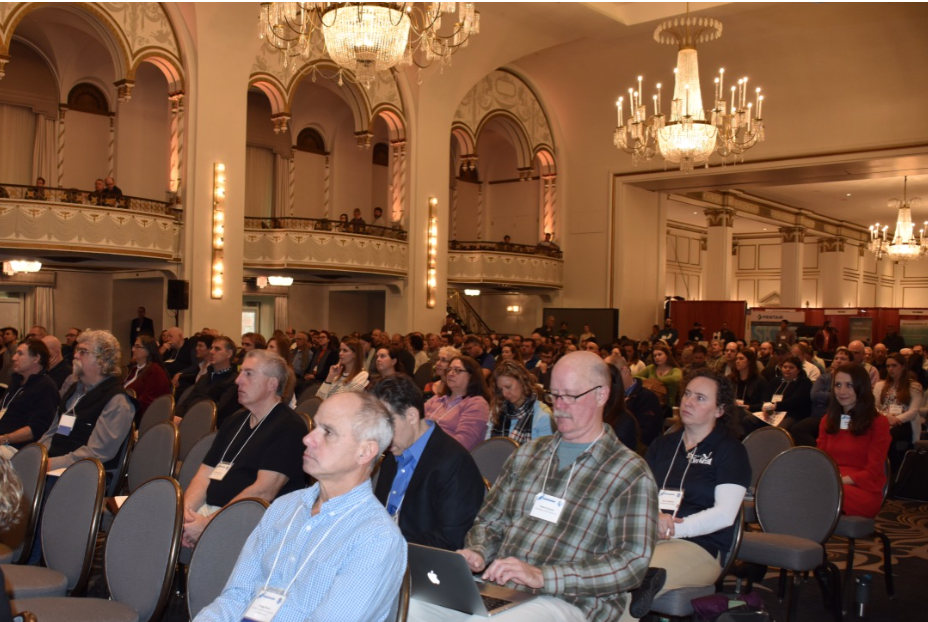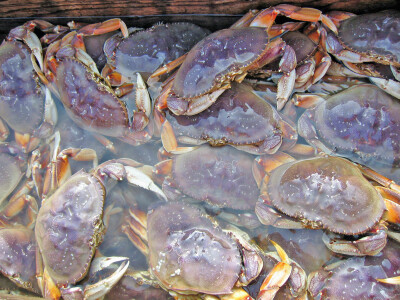To open the Northeast Aquaculture Conference and Exposition on January 9, a panel of ten experts from Prince Edward Island to New Jersey fired off a round of challenges into the ballroom of the Boston Park Plaza Hotel: labor shortages, complex regulations, public opposition, and climate change, among them.
But, for all the concerns, the aquaculture industry represented by some 550 attendees seemed buoyantly optimistic, despite the absence of federal employees furloughed by the partial shutdown of the federal government, many of whom were speakers.
“It’s an aquaculture pep rally,” said Matt Gregg of the Barnegat Oyster Collective in Barnegat Light, N.J., describing the three-day conference, which included field trips, research presentations, and a tradeshow.
Farm-raised seafood is the fastest growing food sector worldwide, according to the UN Food and Agriculture Organization. Globally, aquaculture supplies more than 50 percent of all seafood people eat.
First-time NACE attendee Kevin Thomson of Duxbury Oyster Company in Duxbury, Mass., emphasized the conference was information-intensive. “They’ve brought a lot of different kinds of people into one room,” he said.
That meant not only shellfish, seaweed, and finfish growers, but also researchers in marine biology, ecosystems ecology, climatology, food science and geothermal engineering, who hosted over 100 sessions on their findings.
“The studies have progressed,” noted Travis Ortega of Watch Hill Oysters in Rhode Island, who has attended three conferences. “There’s a lot more knowledge now and not as many studies ‘in progress.' We can apply what we learned when we go back to the farm," he said.
Noticeably missing from the conference were furloughed federal employees, numbering around 35. Among them was The Milford Lab, part of NOAA, a key driver on the conference planning committee.
Still, the presence of federal and state money was felt. Chris Davis, head of the NACE Organizing Committee, said regular registration was at a “bare-bones” rate ($250) because of the support of sponsors. They included the Maine Aquaculture Innovation Center, funded by government grants and other contributions; The Milford Lab: NOAA Northeast Fisheries Science Center; the USDA’s Northeastern Regional Aquaculture Center; NOAA’s Aquaculture Program; the Northeast Sea Grant Consortium; and some seven other Sea Grant entities.
Increasing aquaculture farming is a strategy of the federal government because of the seafood trade deficit. As National Fisherman reported last June, the U.S. imported seafood valued at more than $21.5 billion in 2017 versus exporting $5.4 billion.
The conference spotlighted positive signs that the Northeast is ready to start helping to address that imbalance. Scott Soares of Boston Bay Consulting acknowledged the inflection point. “Growers are getting better at growing,” he said, but now is the time to build market demand domestically and internationally.
Colleen Coyne agreed. She works for Food Export-Northeast, a nonprofit that administers the USDA/Foreign Agricultural Service Market Access Program which provides business development help, including 50 percent cost-sharing to conduct foreign-market promotions. And it has money: in 2017, Food Export-Northeast invested close to $900,000 into its seafood export promotion program. “The industry finally has enough production to take advantage of the services of export,” Coyne said.
But the aquaculture business also needs education and marketing closer to home. One track of the program focused on communications, especially to address people who don’t want aquaculture farms in their backyards. Azure Cygler of the Coastal Resources Center in Narragansett, R.I., discussed the popularity of summer farm tours, although they don’t always attract the salt pond residents and town council members who oppose aquaculture, she said.
In fact, a packed session was devoted to legal issues: the risk of nuisance suits, the permitting morass, employee liability issues, and shutdown due to laws protecting endangered species.
Another sign of the industry’s maturing was the oft-cited need for more labor in the industry. Positive steps include the Fish to Dish internship program developed by New York Sea Grant, a new Master’s Degree program at University of New England in Biddeford, Maine, that combines capture fisheries and aquaculture, and Rhode Island Aquaculture Training Partnership that has an 80 percent job placement rate and is now recruiting veterans. NACE offered a special rate for students and emphasized the importance of attracting young people to the aquaculture industry.
Throughout the conference a consistent theme was the potential of seaweed. It was the buzz among growers, as well as a distinct two-day programming track. Attendees packed sessions on direct seeding of kelp grow rope and advances in sustainable post-harvest processing, among other topics.
The seaweed industry is at its very beginnings, according to co-chair of the seaweed programming and grower, Sarah Redmond, whose company Springtide Seaweed is a pioneer in the business. Right now, she said, the seaweed sector is small and low-tech, making it accessible for newcomers.
Said oyster farmer Matt Gregg, “Oysters are ‘it’ today. I think we’ll see seaweed there in the next ten to fifteen years. It’s healthy, good for the environment, and easy to grow.”
Tim Sheehan, owner of Gulf of Maine, Inc. in Pembroke, Maine, is planning to apply for leases to grow kelp. He currently wild harvests soft shell clams, periwinkles, and American eels, but is interested in seaweed for income diversification. “We can not only be hunter-gatherers,” he says, “but farmers.”







